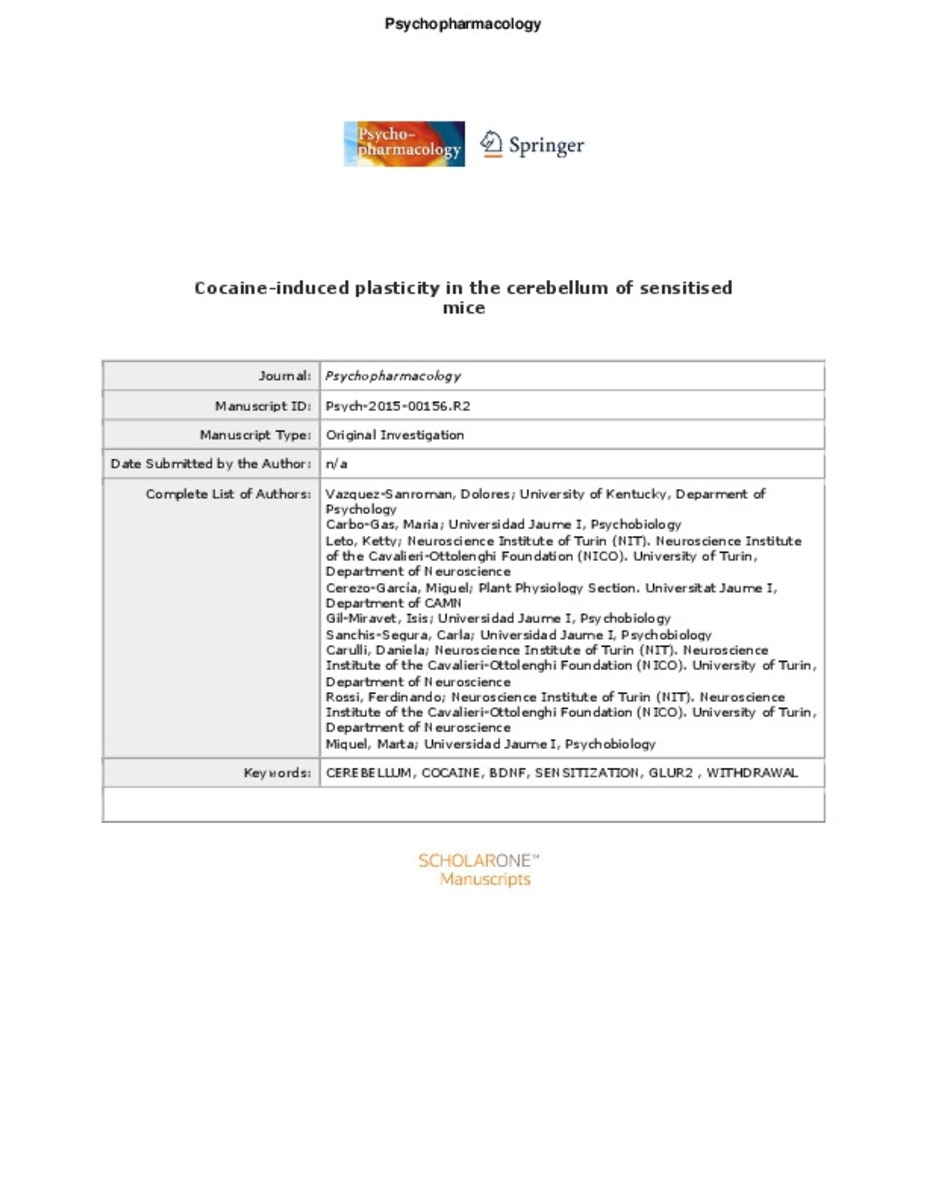Mostrar el registro sencillo del ítem
Cocaine-induced plasticity in the cerebellum of sensitised mice
| dc.contributor.author | Vázquez Sanromán, Dolores | |
| dc.contributor.author | Carbó Gas, María | |
| dc.contributor.author | Leto, Ketty | |
| dc.contributor.author | Cerezo García, Miguel | |
| dc.contributor.author | Gil-Miravet, Isis | |
| dc.contributor.author | Sanchis-Segura, Carla | |
| dc.contributor.author | Carulli, Daniela | |
| dc.contributor.author | Rossi, Ferdinando | |
| dc.contributor.author | MIQUEL, MARTA | |
| dc.date.accessioned | 2016-06-13T14:07:17Z | |
| dc.date.available | 2016-06-13T14:07:17Z | |
| dc.date.issued | 2015 | |
| dc.identifier.issn | 0033-3158 | |
| dc.identifier.issn | 1432-2072 | |
| dc.identifier.uri | http://hdl.handle.net/10234/160654 | |
| dc.description.abstract | Rationale Prior research has accumulated a substantial amount of evidence on the ability of cocaine to produce short- and long-lasting molecular and structural plasticity in the corticostriatal-limbic circuitry. However, traditionally, the cerebellum has not been included in the addiction circuitry, even though growing evidence supports its involvement in the behavioural changes observed after repeated drug experiences. Objectives In the present study, we explored the ability of seven cocaine administrations to alter plasticity in the cerebellar vermis. Methods After six cocaine injections, one injection every 48 h, mice remained undisturbed for 1 month in their home cages. Following this withdrawal period, they received a new cocaine injection of a lower dose. Locomotion, behavioural stereotypes and several molecular and structural cerebellar parameters were evaluated. Results Cerebellar proBDNF and mature BDNF levels were both enhanced by cocaine. The high BDNF expression was associated with dendritic sprouting and increased terminal size in Purkinje neurons. Additionally, we found a reduction in extracellular matrix components that might facilitate the subsequent remodelling of Purkinje-nuclear neuron synapses. Conclusions Although speculative, it is possible that these cocaine-dependent cerebellar changes were incubated during withdrawal and manifested by the last drug injection. Importantly, the present findings indicate that cocaine is able to promote plasticity modifications in the cerebellum of sensitised animals similar to those in the basal ganglia. | ca_CA |
| dc.description.sponsorShip | This work was supported by grants and fellowships: Ministerio de Economía y Competitividad [PSI2011- 29181], FPI-PREDOC2009/05, FPU12/04059, PPF 2013 (13I087.01/1) and UJI (P1.1B2011-42). | ca_CA |
| dc.format.extent | 13 p. | ca_CA |
| dc.language.iso | eng | ca_CA |
| dc.publisher | Springer Verlag | ca_CA |
| dc.relation.isPartOf | Psychopharmacology (2015) 232:4455–4467 | ca_CA |
| dc.rights | © Springer-Verlag Berlin Heidelberg 2015 | ca_CA |
| dc.rights.uri | http://rightsstatements.org/vocab/InC/1.0/ | * |
| dc.subject | Cerebellum | ca_CA |
| dc.subject | Cocaine | ca_CA |
| dc.subject | Sensitisation | ca_CA |
| dc.subject | Withdrawal | ca_CA |
| dc.subject | BDNF | ca_CA |
| dc.subject | GluR2 | ca_CA |
| dc.title | Cocaine-induced plasticity in the cerebellum of sensitised mice | ca_CA |
| dc.type | info:eu-repo/semantics/article | ca_CA |
| dc.identifier.doi | http://dx.doi.org/10.1007/s00213-015-4072-1 | |
| dc.rights.accessRights | info:eu-repo/semantics/openAccess | ca_CA |
| dc.relation.publisherVersion | http://link.springer.com/article/10.1007/s00213-015-4072-1 | ca_CA |
| dc.type.version | info:eu-repo/semantics/submittedVersion | ca_CA |
Ficheros en el ítem
Este ítem aparece en la(s) siguiente(s) colección(ones)
-
PSB_Articles [1292]
Articles de publicacions periòdiques







